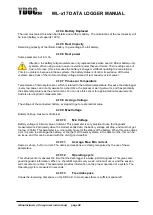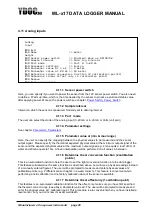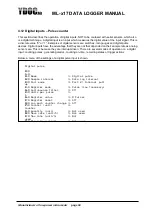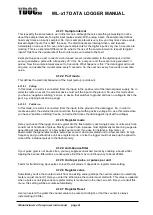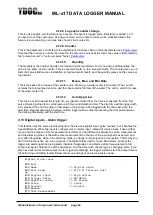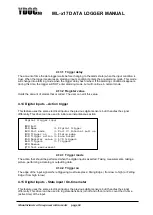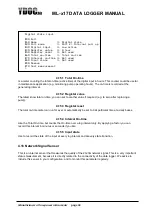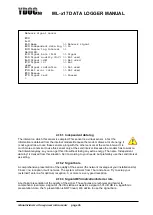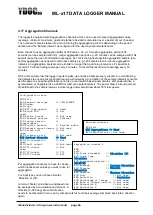
ML-x17 DATA LOGGER MANUAL
Manufacturers of low power instruments
page 31
4.5
General Settings
Here you enter your global settings, like data log interval etc. These are the settings:
4.5.1 Exit
Exits the menu
4.5.2 System Name
Allows the user to give a name to the data logger (up to 32 characters). This name will be used in the
data files, produced by the logger.
4.5.3 Data log interval
This is the interval on which the logger will write a measurement to its SD-card. These records will be
present in the data file and this setting defines the size of the data file per interval. The data log interval
knows 2 different modes:
4.5.3.1
Normal mode
Normal data logging mode, the regular data will be logged
The normal interval must be greater than the alarm interval
and can't be greater than the smallest normal send interval
and can't be smaller than the highest normal sample interval
4.5.3.2
Alarm mode
Alarm mode data log interval defines the (often faster) rate of data logging, during alarming conditions
The alarm interval must be less than the normal interval
and can't be greater than the smallest alarm send interval
and can't be smaller than the highest alarm sample interval
4.5.4 Timestamp round down
This feature allows you to round down the timestamps in the data log to fixed time brackets. Some
sensors will take a few seconds to finish data reading, and as a result you get timestamps like 12:50:07. If
you want to round it down to 12:50:00, you can set the round down to 10 seconds.
4.5.5 Avoid equal timestamps
A log file consist of time stamped records, but as some sensors are logged with an independent interval,
it could occur to have multiple records with the same timestamp. If yo
ur collection software can’t handle
duplicated timestamps check ON this option to add 1 second to consecutive equal timestamped records.
4.5.6 Continuous Alarm Sampling
This is an advanced feature that allows the user to act fast on exceptional situations, while the normal
data log interval is slow. This setting introduces a second interval, which must be faster than the normal
data log interval. First read the basics of the
alarming interval
. Normally, the alarming-mode can only be
entered by awaiting the data log interval, but this (global) setting allows the user to define a faster interval.
The logger will now wake on this faster interval, but not store the data. It must be enabled in the
parameter-settings by means of setting alarming conditions. Only a Sensor with a parameter with
alarming conditions is sampled with his defined sample interval.
Example:
A user has chosen a data log (normal) interval of 10 minutes. The temperature-sensor must NOT get
above 25 degrees. When the temperature reaches the limit, it takes the logger up to 10 minutes, before it
gets into the alarming mode (with a faster alarming interval, of course). Now, the continuous alarming






















